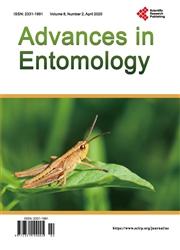Anopheles leesoni Evans 1931, a Member of the Anopheles funestus Group, Is a Potential Malaria Vector in Cameroon
引用次数: 2
Abstract
Background: Understanding the biology of Anopheles malaria vector species is essential to planning effective and sustainable malaria control strategies in endemic countries. This study reported the implication of Anopheles leesoni in malaria transmission in Cameroon, Central Africa. Methods: Mosquitoes were collected in three localities from May 2015 to March 2018 using electric aspirators and Centers for Disease Control light traps (CDC-LT). Anopheles funestus sensu lato (s.l.) mosquitoes were identified as species using polymerase chain reaction assay (PCR). Furthermore, Plasmodium falciparum infection status was determined using the enzyme-linked immunosorbent assay (ELISA) leesoni was found positive for P. falciparum (infection rate: 10.98%) in Cameroon. Conclusion: A very high P. falciparum infection rate was observed in this study in A. funestus s.s., highlighting its high implication in malaria transmission in Cameroon. Furthermore, the detection of P. falciparum infection in A. leesoni calls for more attention towards this neglected vector species.利斯尼埃文斯按蚊1931,一种非氏按蚊群的成员,是喀麦隆潜在的疟疾媒介
背景:了解疟媒按蚊的生物学特性对疟疾流行国家制定有效和可持续的疟疾控制策略至关重要。本研究报道了李氏按蚊在中非喀麦隆疟疾传播中的意义。方法:2015年5月- 2018年3月,采用电诱蚊器和美国疾病控制与预防中心诱蚊灯(CDC-LT)在3个地点采集蚊虫。采用聚合酶链式反应法(PCR)鉴定了褐感按蚊属。此外,采用酶联免疫吸附试验(ELISA)检测恶性疟原虫感染状况,发现喀麦隆leesoni恶性疟原虫阳性(感染率为10.98%)。结论:在本研究中发现了恶性疟原虫在喀麦隆的高感染率,表明其在喀麦隆疟疾传播中具有重要意义。此外,在李氏伊蚊中检测到恶性疟原虫感染,需要更多地关注这一被忽视的病媒物种。
本文章由计算机程序翻译,如有差异,请以英文原文为准。
求助全文
约1分钟内获得全文
求助全文

 求助内容:
求助内容: 应助结果提醒方式:
应助结果提醒方式:


